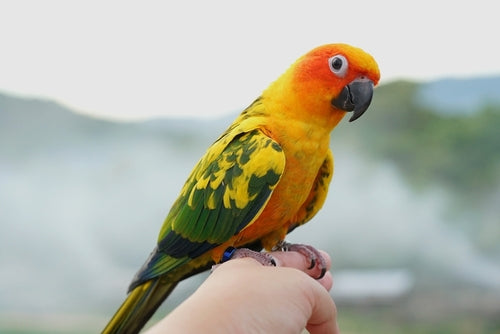You’re the proud new owner of a pet bird, and you can’t wait to bond by handling your feathered friend. But it’s important to take things slowly when attempting to connect with an avian ally. It’s all about building trust and the earlier you can start, the better. Young birds are the best choice, and they’re easier to tame one-at-a-time. Older birds and those with cage buddies can still be tamed, but beware that they will require more of your time and patience. Ask the experts at your local Just For Pets store for advice, and follow these basic steps to hand-tame your bird:
-
Choose a safe position
Birds can become scared by movement above their heads because it mimics the actions of circling predators in the wild. So, don’t position your bird’s cage too low – about your head height is a good guide. Placing the cage in a corner and/or against a wall will also help your bird feel safe.
-
Do not grab your bird
One of the worst things you can do is go straight in for the squeeze. Let your bird settle into its new space and become comfortable before you attempt to handle it.
-
Approach slowly
Help your bird get used to your presence by approaching the cage slowly to change its food and water. The aim is to demonstrate that you are not a threat, so avoid sudden movements and loud noises. Do this several times before you attempt to handle the bird.
-
Watch for signs of distress
If your bird shows signs of distress as you approach the cage, stop and stand still. Signs of distress may include leaning back, sucking in its feathers or squawking. By standing still, you’re aiming to show the bird that you’re not a threat but that you’re also not going to ‘reward’ their fright by retreating. Wait until the bird is calm before continuing to slowly approach the cage or walking away.
-
Use food
When your bird appears to be more comfortable with your presence, you can start to drop treats into the cage. After a few drops, it’s time to offer the bird food directly from your hand. Ask your Just for Pets experts for advice on which treats to choose.
-
Place your hands inside the cage
The next step is to begin placing your hand inside the cage to help your bird get used to its closeness. Gently rest your hand on the base of the cage and repeat a few times until your bird seems calm and content with your presence.
-
Touching your bird
Now that your bird is used to your hand in the cage and is taking treats from your hand too, it’s time to try touching their feathers. While your bird is eating from one hand, use the other to gently stroke its back, neck or tummy. If your bird appears distressed by the action, stop and try again later. It may take many attempts before your bird is comfortable with being touched.
-
Become their perch
The next progression is sticking out one of your fingers for your bird to perch on. Use your other hand to hold a treat and coax them onto your finger perch. It’s important not to give the bird the treat if they don’t perch on your finger. Keep trying until the bird perches on your finger, then reward it with the treat.
If this step isn’t working after multiple attempts, substitute your finger with a stick. Follow the same process of using a treat to coax the bird onto the stick. Once the bird is comfortably perching on the stick, try again by replacing the stick with your finger.
-
Be patient
All of the steps above may need to be repeated many times before they’re successful. Like humans, all birds have different personalities and some will take to taming more quickly than others.
-
It’s time for tricks
Once your bird is comfortable being touched and perching on your finger, it may be time to progress to teaching it tricks such as waving, climbing ladders or fetching. Check YouTube for plenty of how-to videos, but remember to follow the same principles listed above – start slowly, make sure your bird is comfortable, reward with food, and be patient.
Article supplied by Just For Pets

